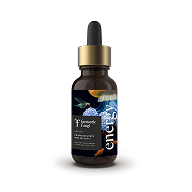
Meet Your Mushrooms: Get to Know 10 of Our Favorites
Worldwide, we each consume about 20 pounds of mushrooms a year. That amount is expected to increase as more people learn about the magic and mystery (not to mention the environmentally friendly nutritional benefits) of mushrooms! With over 2,000 different species of edible mushrooms that we know of so far, there’s a lot to learn about our mycelial allies.
Read to get to know 10 of our favorite mushrooms, including tips on how to integrate them into your everyday routines and rituals.
Chaga
Scientific name: Inonotus obliquus
Chaga mushrooms are among the highest sources of natural antioxidants — and they offer potent immune support.* Commonly found on birch trees in cold climates across Eastern Europe and North America, Chaga grows as a sclerotia (canker) on a host tree. (Finding a chaga fruiting body is actually quite rare!) Chaga looks more like burned wood than a mushroom. It also goes by cinder or birch conk, clinker polypore and black gold. Chaga is traditionally used in Russian herbalism, and this mushroom offers support against UV exposure.*
Did you know? Chaga is too hard to eat like the mushrooms you find at the grocery store. That’s why, traditionally, it was simmered as a tea.
Tips for using Chaga: Try adding powdered Chaga extract to your morning tea. It’s delicious with chai spices!
Cordyceps
Scientific name: Cordyceps sinensis (wild), Cordyceps militaris (cultivated)
Cordyceps is an adaptogenic mushroom that promotes stamina, endurance and energy.* Popular among athletes and those who want to maintain an active lifestyle, Cordyceps’ use dates back to imperial China.* In the wild, these orange mushrooms grow on caterpillars, but today cultivated, vegan Cordyceps are widely available.
Did you know? Cordyceps was once so valuable that its use was restricted to noble people.
Tips for using Cordyceps: This is another mushroom that needs to be extracted or processed. Try adding Cordyceps powdered extract to smoothies or protein shakes.
Lion's Mane
Scientific name: Hericium erinaceus
Lion’s Mane is a tasty mushroom that supports the brain – including memory, focus and nerve health.* Native to Europe, Asia and North America, Lion’s Mane is a large, shaggy white nootropic mushroom that resembles a brain (and a lion’s mane, of course). In addition to cognitive well-being, Lion’s Mane also supports gut and immune health.*
Did you know? Lion’s Mane is also known as the “hedgehog mushroom.”
Tips for using Lion’s Mane: While you can take it as a supplement, fresh Lion’s Mane is a delicious swap in seafood and chicken recipes. It is a tender and flavorful mushroom – look for it at your local farmers market!
Maitake
Scientific name: Grifola frondosa
Maitake is known as hen of the woods or the dancing mushroom, a name that dates back to feudal Japan, where they were worth their weight in silver. Native to Asia, Europe and North America, Maitake mushrooms support immune health, healthy blood sugar levels within normal ranges and some aspects of cardiovascular health.*
Did you know? Until 1979, Maitake were only available in the wild! Cultivated maitake tend to have a milder flavor than wild ones, but both are delicious.
Tips for using Maitake: Brush with your favorite marinade or dry rub, then sear in a cast-iron skillet.
Oyster mushrooms
Scientific name: Pleurotus ostreatus
Often used in myoremediation, Oyster mushrooms grow in temperate and subtropical forests in most areas of the world. They come in beautiful hues of pink, yellow, white, brown, blue and gray. Packed with nutrition and easy to grow at home, oyster mushrooms were first cultivated in Germany during World War I, to provide a food source. Oyster mushrooms offer immune support, and, in supplement form, they support healthy cholesterol levels already within normal ranges.*
Did you know? Their name refers to their appearance (not their flavor)!
Tips for using Oyster mushrooms: Like Maitake, Oyster mushrooms are tender and tasty. Use them in place of chicken in your favorite recipe.
Portabella/Button/Cremini
Scientific name: Agaricus bisporus
While these three mushrooms look quite different, they’re all related! Portabella mushrooms are the same type of mushroom as brown (cremini) and white button mushrooms. They are simply a larger version of brown buttons/baby bellas. Though they can be found in most supermarkets, Portabella mushrooms do possess functional benefits, including immune support and plenty of nutrition.*
Did you know? Most commercially grown Portabella, button and cremini mushrooms come from the same small Pennsylvania town, Kennett Square, the mushroom capital of the US for 150+ years.
Tips for using Portabella, button and cremini mushrooms: Trying to eat less meat? Swap in minced mushrooms for half the meat called for in any recipe. These mushrooms also make delicious mushroom jerky.
Reishi
Scientific name: Ganoderma lucidum or Ganoderma lingzhi
Reishi mushroom is known as the “mushroom of immortality” and the queen of mushrooms. It is an adaptogen that supports a healthy response to stress, as well as a tonic that promotes longevity and healthy aging.* Used for over 4,000 years, Reishi supports healthy sleep and rest, as well as immune health.*
Did you know? Reishi grows out from its host tree like a lacquered little roof. The mushrooms have an ombre pattern ranging from mahogany and eggplant to white.
Tips for using Reishi: This mushroom is quite dense, so it’s usually extracted before use. Reishi pairs well with chocolate, so use it in hot cocoa or homemade truffles.
Shiitake
Scientific name: Lentinula edodes
Shiitake mushroom has been used for millennia to support immune health in China and Japan.* Its name comes from the Japanese word for “oak,” since the tasty mushroom grows on fallen broadleaf trees. Widely studied for their immune-supporting qualities, Shiitake mushrooms also offer antioxidant support and promote skin, liver and cardiovascular health.*
Did you know? Shiitake are the second most commonly consumed mushroom globally (behind the Portabella family).
Tips for using Shiitake: Simmer fresh or dried shiitake for a flavorful, nutrient-rich broth or stock. Add your favorite herbs and aromatics.
Tremella
Scientific name: Tremella fuciformis
Tremella is a type of mushroom known as a jelly fungus. It can hold hundreds of times its weight in water. It was traditionally used to promote healthy skin (aka beauty!) and bones and to support a healthy memory and metabolism.* Tremella also offers support to the immune system.*
Did you know? Tremella is also known as snow fungus, and it is used with fruit and herbs in delicious desserts in Chinese cuisine.
Tips for using Tremella: Look for Tremella extracts to add to smoothies and drinks. If you’re cooking with dried Tremella mushroom, soak it for a couple of hours, then rinse well and trim off any tough parts.
Turkey Tail
Scientific name: Trametes versicolor or Coriolus versicolor
Turkey Tails are the most widely researched mushrooms due to their support of the immune system.* These striped mushrooms are used extensively in China and Japan. They get their name from the colorful fans their fruiting bodies form, which resemble the tails of turkeys. Turkey Tails offer antioxidant support and are native to North America, Europe and Asia.
Did you know? This mushroom has many look-alikes (as do many mushrooms), so always make sure you’ve properly identified it.
Tips for using Turkey Tail: Like Reishi and Chaga, Turkey Tail is a tough mushroom. Reach for extracts or simmer it into a broth or tea!









